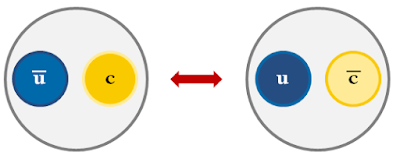TL;DR
- A charming cosmological conundrum
- The star named after me :D
- Liftoff! Land! Launch again!
Current events
Unfortunately the Further Learning Appendix of Astronomical Returns isn't complete yet (I'm sorry! I promise I'm working on it!) but these are the two relevant background pages in case you're curious (Section 1.6 and Section 2.7).
Scientists at the Large Hadron Collider announced a new clue to one of the largest unsolved questions in physics - why does matter exist in the Universe? If you've heard of antimatter, you'll know when matter and antimatter collide, they annihilate in a burst of energy. The Big Bang should have created equal amounts of matter and antimatter, which should've all collided and left a Universe totally devoid of matter.
Something clearly tipped the balance in favor of matter, so scientists search for asymmetries in the fundamental particles of the Universe. In this recent discovery, particles called D mesons, which are made of charmed and up quarks (two of the fundamental particles of the Universe), were found to decay (ie break apart) 0.1% less than their antimatter counterparts (seems small, but it adds up)! These asymmetries help us paint a clearer picture of the Big Bang and the origins of our Universe
A few caveats though - UY Scuti is largest by radius, but there are many stars that are more massive (the most massive star, R136a1, is 315x more massive than the Sun, vs UY Scuti at 30x). UY Scuti is also a variable star, meaning its expands and contracts regularly, and our estimate of its size has a large margin of error. Still, if it bears my name, it's good enough for me!
Scientists at the Large Hadron Collider announced a new clue to one of the largest unsolved questions in physics - why does matter exist in the Universe? If you've heard of antimatter, you'll know when matter and antimatter collide, they annihilate in a burst of energy. The Big Bang should have created equal amounts of matter and antimatter, which should've all collided and left a Universe totally devoid of matter.
 |
| Image Credit: here |
Something clearly tipped the balance in favor of matter, so scientists search for asymmetries in the fundamental particles of the Universe. In this recent discovery, particles called D mesons, which are made of charmed and up quarks (two of the fundamental particles of the Universe), were found to decay (ie break apart) 0.1% less than their antimatter counterparts (seems small, but it adds up)! These asymmetries help us paint a clearer picture of the Big Bang and the origins of our Universe
 |
| Left: The D meson (anti-up quark and charmed quark) | Right: The anti-D meson (up quark and anti-charmed quark) |
Today I learned
Everyone knows stars are big, but if you're a nerd like me, you may have wondered, "what's the largest star we know of?" Well I looked it up - turns out it's named after me! UY Scuti (my last name is Uy) is located in the constellation Scutum about 5,000 light years away. It's so big, it could fit 3-4 billion Suns inside of it, and its radius extends 8x further than the distance between the Earth and the Sun!
This week in space history
On March 30, 2017, SpaceX achieved the first reflight of a previously launched orbital rocket, launching a communications satellite for the Luxembourg-based company SES. This rocket had previously launched an ISS cargo mission for NASA in April 2016.
 |
| SES-10 launch: the Falcon 9 after sticking the drone ship landing |
This launch was a major milestone for SpaceX, which had long promised rocket reusability to lower the massive costs of space launches. Most rockets are expendable, meaning they launch just one time, then burn up in the atmosphere on reentry. Though the Space Shuttle was partially reusable, it was extremely expensive to refurbish after each flight, negating most of the cost savings. SpaceX now regularly launches previously-flown rockets.





No comments